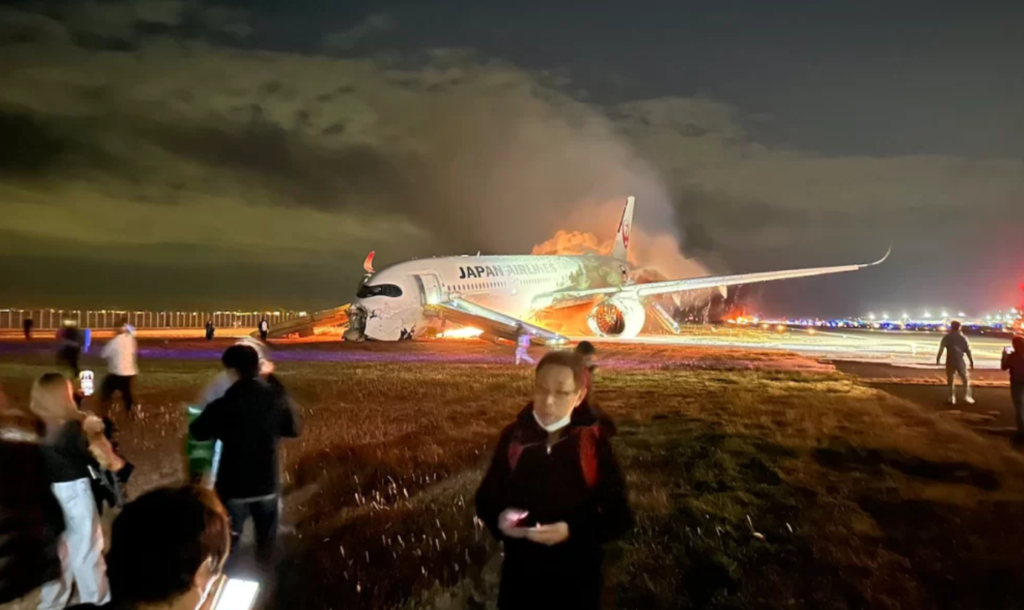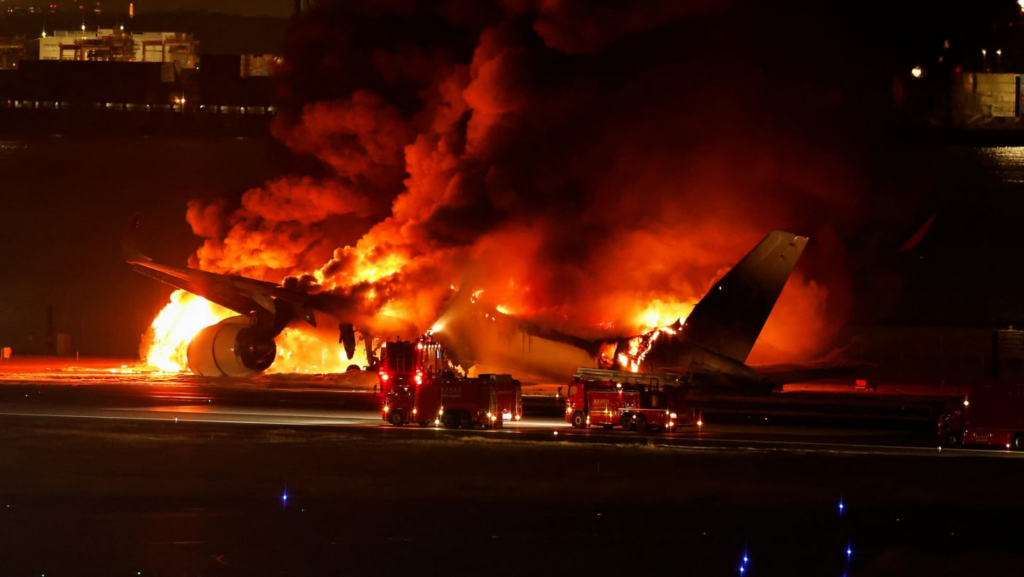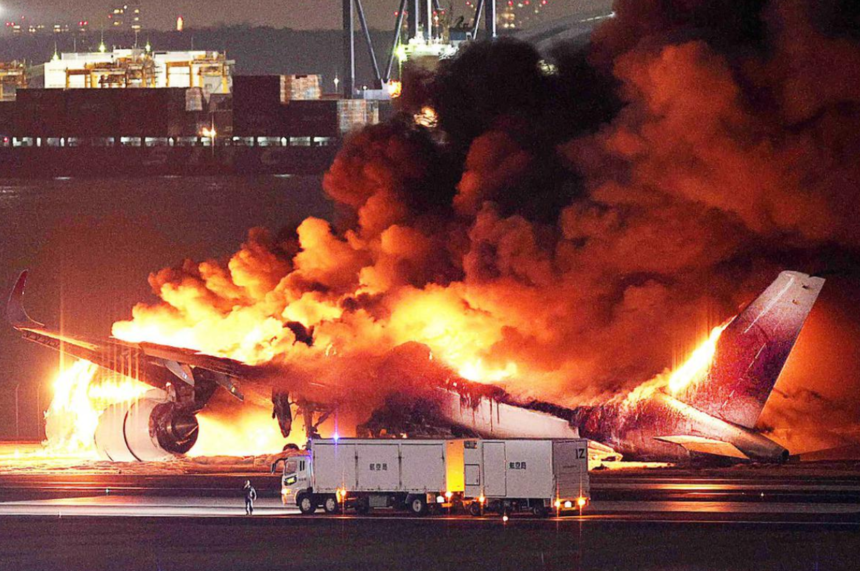Passengers wait in line at a Japan Aircraft service desk at Tokyo’s Haneda International Airport after Tuesday, January 2, flight cancellations due to an aircraft crash.
Five passengers lost their lives in a Tuesday collision between two aircraft at Tokyo’s Haneda airport. Japan Airlines and Airbus are both involved in the investigation. Meanwhile, the number of fatalities from the earthquake that struck western Japan on Monday has increased to 57.
Investigation into the crash ongoing: According to an airline representative, Japan Airlines is cooperating with the inquiry to ascertain the cause of the fatal collision between a Japan Airlines Airbus A350 and a Japan Coast Guard aircraft. The preliminary investigations indicate that the pilots of the Japan Airlines flight did not see any other aircraft on the runway before to landing, however the investigation is still underway. The company that makes Airbus says it will send a team to assist with the incident investigation on Tuesday.
Five killed while providing earthquake relief: The Japan Coast Guard (JCG) plane that collided with the Japan Airlines plane claimed the lives of five of its crew members; the captain is still critically injured. The Coast Guard aircraft was scheduled to arrive in Niigata Prefecture to support relief efforts following the earthquake.

Twelve or more passengers hurt: After the Japan Airlines aircraft 516 caught fire, seventeen people were hurt, and four of them were hospitalized. They did not disclose any more information about their injuries. The majority of the flights have been canceled and over 100 fire engines have been sent to the area of the incident. Death toll from earthquake rises: There are now 57 fatalities reported from the 7.5-magnitude earthquake that rocked Japan’s west coast on Monday. On Monday afternoon, an earthquake struck the Noto Peninsula in the central prefecture of Ishikawa, causing buildings to collapse, fires to start, and tsunami warnings to be sent as far away as eastern Russia.

After the earthquake, the Noto Peninsula was damaged
Following Monday’s 7.5-magnitude earthquake, more over 30,000 people are in evacuation shelters and over 45,000 houses in Ishikawa Prefecture are without power. The earthquake resulted in significant damage to buildings and roads, prompting tsunami warnings in six prefectures. According to a government official, Wajima City, Shika Town, and Anamizu Town are thought to have sustained the worst damage.

Approximately 500 persons are left stranded at Noto Airport due to damage caused by an earthquake to the terminal. They are receiving food and blankets, but they are unable to leave due to damaged surrounding roads. Following the earthquake, Ishikawa prefecture in Japan has numerous cities with damage. Among the worst affected is Wajima City, where 14 buildings may still have people trapped inside of them after 25 fell.
ALSO READ: Jr NTR Returns From Japan Safely After 155 Earthquakes Hit The Country, Expresses Sympathy

There are already 57 fatalities from the Japan earthquake
Japan’s state network NHK reported that 57 people have died as a result of the 7.5 magnitude earthquake that slammed the country’s west coast on Monday. The report cited officials from the Ishikawa prefecture. On Monday afternoon, an earthquake struck the Noto Peninsula in the central prefecture of Ishikawa, causing buildings to collapse, fires to start, and tsunami warnings to be sent as far away as eastern Russia.

He stated that after flying over the peninsula, which is renowned for its agricultural and maritime beauties, officials in helicopters saw big fires, landslides, and damaged roads. We must organize every mode of transportation, including air and sea travel, in order to protect the way there. Since last night, we have been attempting to get staff, supplies, and goods there, Kishida stated.

The Airbus team will support the airport collision investigation
Maker of aircraft Airbus announced that it will send a team to assist in the investigation of the Tokyo incident on Tuesday between an Airbus A350 operated by Japan Airlines and a Japan Coast Guard aircraft. In a statement, Airbus stated that it is “presently dispatching a team of specialists to assist the Authorities” and that the Japan Transport Safety Board will be in charge of the investigation.

According to Airbus, Japan Airlines received the A350 aircraft that was involved in the incident on November 10, 2021. According to Airbus, Rolls-Royce Trent XWB engines propelled the aircraft. According to Airbus, “the precise circumstances of the event are still unknown.” According to Jennifer Gabris, a spokesman for the National Transportation Safety Board in the US, the agency “has not received a request for assistance at this time.”

A survivor of the Japan Airlines disaster describes “fire coming out of the engines”
Upon arrival, Satoshi Yamake, a 59-year-old passenger on Japan Airlines, reported that everything appeared normal until he noticed a fire. “There was no shock or anything when we landed,” he said after being pulled from the flaming collision. Just before the plane was ordered to leave, he claimed to have seen a fire. “But then we saw fire coming out of the engines and I found it strange. Just as I was thinking why the fire was burning for so long, an announcement came and said we probably hit something on the runway and we have to now evacuate the plane,” Yamake said. “We could smell some smoke but passengers were not panicking a lot,” he added. “I wasn’t particularly afraid. I was thinking that the plane probably won’t blow up by now since we’ve already landed,” Yamake remarked. “As long as everyone exits the plane in a timely manner, we should be alright.”

# Japan Aircraft
Click here, to get the latest post on HNN.
ALSO READ: Exploring The Enchanting Ellora Caves : A UNESCO World Heritage Site
Image Source: Google




































